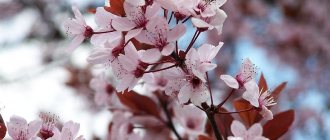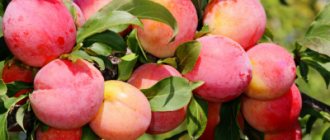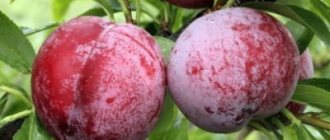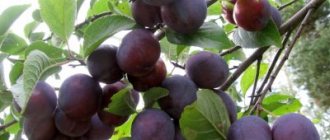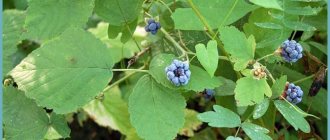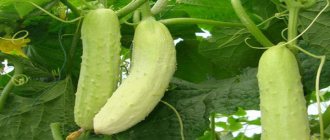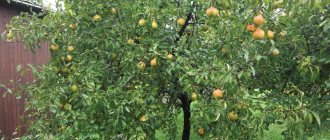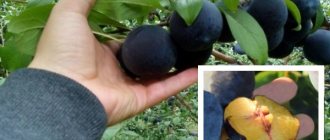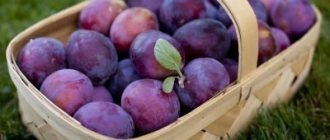A tree from the category of vigorous-growing. The crown of medium density creates a round-oval shape. An erect, dark gray standard covered with a small number of cracks.
The oval leaf has a pointed, blunt tip and an arc-shaped base. Its average dimensions are 7.4 x 4.5 cm.
Attached with a long petiole about 2 cm. Paired appendages at the bottom of the leaf (stipules) are about 1 cm long and have a pale green color.
One saucer-shaped flower up to 2.5 cm in diameter blooms from one ovoid bud. White petals measuring 1.2 x 1.3 cm are loosely closed. There are only 22 stamens.
The straight pistil is about 0.8 cm long. The round stigma is located above the stamens. Ovary without pubescence.
Oval sepals measuring 2.5 x 3 cm with slight pubescence. Not pubescent pedicel measuring about 1.3 cm.
Fruit shape:
- at the base – rounded;
- at the apex – depressed.
The fruits are large with equal barrels and weighing up to 40 grams . Fruit diameter is up to 40 mm. The color is pink with a reddish tint.
The thin, dense skin can be easily removed from the fruit. Without pubescence. A small presence of brown subcutaneous dots.
The presence of a waxy coating, quite abundant. There is a seam from base to top, but no cracking.
Characteristics of pulp:
- uniform yellow color;
- juiciness;
- good density;
- fine fiber;
- not prone to darkening when exposed to air.
The round stone makes up 3.9% of the pulp. Its size is 1.8x1.6x1 cm.
Plum Renclod Altana: characteristics of the variety
Plum Renclod Altana: photo of the variety
- The Renklod Altana plum tree is quite tall. The crown is spread out, rounded and elongated, the table is straight, the color of the bark is gray, with slight irregularities.
- The foliage is also round and elongated. The leaf parameters are seventy-four millimeters in length, forty-five millimeters in width.
- The size of the cutting is about two centimeters. The size of the stipules is up to one centimeter, green in color with a light tint.
- Renclod Altana plum buds produce one bud, flat, about twenty-five millimeters in size. The color is snow-white, the petal size is about twelve millimeters long and about thirteen millimeters wide. They don't grow side by side. There are twenty-two stamens.
- The size of the pistil is about eight millimeters; the stigma is round in shape and held above the stamens. The ovary is smooth.
- The sepals are about twenty-five millimeters long and three centimeters wide, fleecy. Color stalk up to thirteen millimeters in size.
- The fruit of the Renclod Altana plum variety is depressed on top and round in general appearance. The size of the fruit is large, even, weighing about forty grams. The size of the fruit is about forty millimeters. The color of the fruit is pink with a red blush.
- The peel is good and can be removed easily. Not fluffy. There are dark spots under the skin.
- There is also a small layer of light plaque. There is a tight seam.
- The contents inside are yellow in color, juicy, grainy, pleasant, tasty. The taste is at a good level. Sweet plum, with a hint of sourness.
- The seed takes up four percent of the fruit. Its parameters are eighteen millimeters long, sixteen millimeters wide, and the thickness of the bone is about one centimeter.
Disease and pest control
The Renclod plum variety demonstrates resistance to diseases and pests. But if the plant lacks nutrients, moisture, or has suffered from frost, then it can be affected by moniliosis, gum disease and attacked by aphids, plum sawflies, and codling moths. Therefore, to prevent the tree from getting sick and becoming a center for pests, it is important to take protective measures that will minimize the risk of such phenomena.
Disease and pest control
Renclod plum is valued by gardeners for its regular yield, unpretentiousness, resistance to low temperatures, beautiful appearance and excellent taste. Its tantalizing aroma and exquisite taste will not leave anyone indifferent.
Description of Chinese plum
Chinese plum growers are tempted by early fruits (2-3 years after planting) and their high yield.
And the incredibly low pest susceptibility and low disease susceptibility add a few more benefits. The Middle Kingdom plum resembles a large shrub or small tree with a branched, spherical crown and reddish-brown, smooth shoots.
A special feature of the Chinese plum is its early (with or before leaves), grandiose and rich flowering, which gives the fruit plant an incredibly charming appearance. Agricultural producers are very excited about growing new varieties of Chinese plum. By crossing the American plum with the Chinese plum, it was possible to develop regionalized varieties for the middle zone.
The next part of this article will be devoted to a description of plum varieties.
Landing Features
Planting plums is practically no different from planting other fruit crops, but you should pay attention to two main points:
- The seedling should not be buried too deep. This can cause the bark to warm up and depress the tree, which over time will negatively affect growth and fruiting.
- For two years after planting, the tree must be secured with stakes. Since the Renclod Altana plum is a vigorous-growing variety, a fragile tree may break in strong gusts of wind.
- Appearance. The height of one-year-old seedlings is 1.2 m, two-year-old seedlings are 1.5 m. The bark of the trunk and branches should be uniform in color, smooth, without wrinkles, bulges, or ulcers.
- Root system. The root is well developed. The main roots are at least 12 cm long. A large number of fibrous roots are required. You should not purchase seedlings with an open root system with a large lump of earth, since in this way unscrupulous sellers can disguise dried and damaged roots.
Dates and place of landing
Both autumn and spring are suitable for planting plums. In autumn, seedlings are planted in the second ten days of September, before the onset of the first frost. Spring planting is carried out in April, before buds open.
Areas with different soils are suitable for growing plums. The main requirement is soil fertility and looseness. The acidity of the soil should be neutral or slightly acidic.
Plum is a moisture-loving crop and does not tolerate drought well. However, excess moisture also negatively affects the tree, causing various diseases that lead to withering and death of the plant. Therefore, the groundwater level in the area should not be less than 1.5 m.
The plum variety Renclod Altana blooms quite early. To prevent spring frosts from damaging the flowers, it is not recommended to plant the tree in lowlands. Small slopes or flat areas are more suitable for plums.
Selection of planting material
Seedlings should be purchased exclusively from specialized retail outlets and nurseries.
Quality indicators of planting material:
For planting it is better to use one-year-old seedlings
Site preparation
It is necessary to plant plums in a prepared planting hole. It is prepared in the fall. To do this, dig a pit 70–80 cm wide and 60–70 cm deep. A nutritious soil mixture is prepared from the excavated soil by adding 2 buckets of rotted compost, 40–50 g of superphosphate, 20–30 g of potassium sulphide. The foundation pit is filled with the resulting mixture, and a layer of clean earth is poured on top.
If for some reason the hole was not prepared in the fall, you can enrich it with nutrients 10–14 days before planting the seedling. To do this, mix the excavated soil with rotted compost in a 2:1 ratio and fill the hole with it.
Step by step process
After planting, it is recommended to mulch the tree trunk with humus, peat or dry soil.
The distance between neighboring trees should be 2.5–3 m. During the first months after planting, it is important to monitor the level of soil moisture and, if necessary, regularly water the plant.
Video: planting and fertilizing plums
Plum propagation
Plum propagation occurs in several ways:
Planting seeds
Growing plums from pits
This method is usually used to obtain rootstocks. To get a good seedling you need:
- Healthy and large seeds are thoroughly washed and cleared of pulp , then soaked in water for 4 days, while the water must be changed and the seeds stirred periodically.
- After this procedure, they are thoroughly dried and stored in a glass jar .
- Then you need to mix the seeds with wet sand or sawdust and leave them to infuse at a temperature of +1 to -10 degrees for 180 days.
- Initially, the seeds are germinated as seedlings , after which the seedlings are transferred to open ground.
Graft
This procedure is carried out during the period of active movement of juice, that is, in April-May or July-August. There are 2 main methods of grafting: into the split and behind the bark .
Root growth
In the fall, the root that connects the mother plant and the shoot is cut, and in the spring the shoots, along with the roots, are dug up and transplanted to a new, separate place.
Root cuttings
Scheme of plum propagation by root cuttings and shoots
- The roots of a young tree at a distance of 1 meter from the trunk; for adult plums, the distance increases to 1.5 meters.
- The length of the roots used should be 15 centimeters and the width 1.5 centimeters.
- If the cuttings were dug in the fall, then they are stored in a trench 50 centimeters deep, sprinkled with a mixture of peat and sand. You can also save the cuttings in the basement, covering them with damp sawdust and moss.
- At the end of April, soil should be prepared consisting of one part peat mixed with 3 parts sand.
- cuttings are planted in it obliquely or vertically , then they are covered with film.
- The upper ends are buried 2 centimeters, then they are mulched with sawdust or peat .
- Before shoots appear, cuttings need to be protected from bright light and drying out.
- If several shoots sprout, then the strongest one is selected .
- Plants are fed with several times a season .
- For the winter, the shoots are moved into the house and grown to a height of 1-1.5 meters, then the trees will be ready to move into the garden.
Plums belonging to the Renklod variety have excellent taste. Their pulp is called dessert or marmalade , so every gardener dreams of growing such a tree in the garden. If you choose the seedling correctly, then such a tree can be planted even in the central region of Russia.
Agrotechnics of cultivation
Landing
The process of planting a plum of this variety is similar to that of planting any other fruit tree.
Features of planting this variety
But there are two special points:
- The seedling must not be buried. Strong deepening contributes to warming of the bark and oppression of the tree. As a result, slow growth and poor fruiting.
- Within two years after planting, the young tree is fixed with pegs. The Renclod Altana plum is a vigorous variety, so a strong wind can break a fragile trunk.
What season should I choose to plant a tree?
Planting can be done both in spring and autumn.
For autumn planting, this is mid-September, before the first frost occurs. In spring - April, before the buds begin to bloom.
Soil and place
In what soils can plums be grown? On any, but it is important to comply with two basic requirements: looseness and fertility of the soil, as well as weak or neutral acidity.
Plum grows well in sunny, well-lit places. Shade or partial shade provokes a decrease in yield and also impairs the quality of the fruit.
The described plum variety is quite moisture-loving and does not like drought. But excess moisture is also undesirable for a tree, as it provokes the development of various diseases that can cause the death of the tree.
Plum blossoms occur quite early, so there is always a fear that spring frosts will damage the delicate flowers. This is why it is not recommended to plant plum trees in lowlands. Plains or small hills are better suited for this.
Saplings
It is necessary to buy Renclod Altana plum seedlings strictly in nurseries or specialized retail outlets.
To choose the right seedling, you need to be aware of some nuances
First. Tree age
Try to choose annual trees for planting. A one-year-old seedling has an average height of 1.2 meters, a two-year-old one - 1.5 meters.
Caring for colored hair at home
Second. Bark and root
When choosing, you need to pay close attention to the bark. It should be uniformly colored, smooth to the touch, without holes or bulges.
The tree must have a well-developed root, the length of the main roots is at least 12 cm. There must be a developed fibrous root system.
You cannot buy a tree with a lump of earth, because... sellers may hide damaged root systems.
Third. Proper storage
It is better to store the seedling before planting in a dark room, while the roots can be wrapped in burlap or sprinkled with earth.
Arrangement of the pit
The fruit tree is planted in a planting hole, which must be prepared in advance. Preparations are carried out in the autumn.
To do this, dig a hole 70–80 cm wide to a depth of 70 cm.
The excavated soil is used to prepare a nutrient mixture. To do this, add to the ground:
- rotted compost in the amount of 2 buckets,
- 40–50 g superphosphate,
- as well as 20–30 g of potassium sulphide.
The resulting mixture is returned to the pit and sprinkled with clean earth on top.
But if it so happened that in the fall it was not possible to prepare the hole. This can be done in the spring, about 2 weeks before planting. Preparation consists of mixing 2 parts soil with 1 part compost.
After planting and watering, the hole is mulched with dry soil, peat or pine needles.
Trees are planted at a distance of approximately 3 m from each other.
At first, it is important not to let the soil dry out!
Pollination
The Renclod Altana plum is a self-sterile variety. Therefore, cross-pollination will help increase the ovary.
You can use an artificial fertilization method, or you can plant a plum of the specified variety next to pollinating plum varieties (see photo):
- Renklod green,
- Hungarian homemade
- Renklod Ulena.
Nuances of cultivation and care
What should you consider when landing?
- Greenwood plums are planted only in the spring - before the flowers begin to bloom. Seedlings purchased in the fall are buried in the snow.
- Only an area that is well-warmed by the sun and sheltered from the wind is suitable for planting. Shade and drafts negatively affect taste and yield.
- Greenhouses and pollinating varieties will take up quite a lot of space on the site. The minimum distance between trees is equal to twice the diameter of the crown, between rows of plantings - another 0.8–1 m more. One plum needs 8–9 m² to feed.
- Sloes, common and hybrid cherry plums, and Chinese plums are useless as pollinators.
- If there is even the slightest chance of stagnation of water and humid air in the chosen place, build a bulk hill about 60 cm high. The same thing applies when it is unknown how close the groundwater is to the surface.
Planting greenweed in the ground is a procedure that even a novice gardener can handle.
How to properly care for renclod?
Agricultural technology does not have any significant features compared to classic plums. Some nuances are important:
- The soil is watered so that it is well saturated with water to a depth of 35–40 cm. The plum roots do not reach further. It is especially important to provide the spring crop with moisture from the moment of flowering until the formation of fruit ovaries.
- Renklod reacts positively to rotted manure or humus applied under the tree in the fall. Complex mineral fertilizers must contain magnesium, zinc, copper, manganese, boron, and iron.
- Install supports under the branches in advance. Under the weight of the harvest, not too thick shoots of the greenweed may break.
- The crown is most often formed in a sparsely tiered manner, leaving on each of the tiers, located at a distance of 50–60 cm above each other, 3–4 skeletal and twice as many semi-skeletal branches. As soon as the plum begins to bear fruit, pruning is reduced to the required minimum. We must not forget about sanitary pruning.
- Renklod always sets more fruits than can ripen on the tree. It is necessary to thin out the ovaries, leaving the most well located ones. Make sure that the plums do not touch. The next year after planting, pick off all the flowers.
- The trunk circle, approximately the same in diameter as the crown, is kept clean and regularly loosened. A lawn is not sown under a plum tree, flowers are not grown, herbs or green manure are not planted. The root shoots are also subject to destruction.
Planting and fertilizing plums - video
Advantages and disadvantages
Renclaud Green is the founder of almost the entire series of this process. The general characteristic is that seed production is capable of preserving all the characteristics and characteristics.
They have the best taste characteristics. Their meat is thick and juicy. However, one of the disadvantages of this variety is that it often does not tolerate transportation and has a relatively short shelf life. All representatives are characterized by large fruit sizes: The weight of the fruit can reach 50 g.
In addition to the described types of Tenants, there are others:
- Soviet
- Yellow
- Earlier
- Kursakov.
Description of the type of plum Red Ball: //6.com////sliva..
They also include all the characteristics of the entire variety and are the preferred choice when planted for harvest, fresh consumption and processing.
Below we offer you the opportunity to watch a video about plum varieties:
Page 2
Chinese plum is not very popular in the central part of our country.
This “Asian” comes from the Middle Kingdom, where it was tamed by imperial gardeners centuries ago.
It is most popular in the regions of the Far East, the Urals and Siberia, as it has amazing frost resistance - up to -56 degrees Celsius.
Extensive family
Renklod Kolkhozny
This drainage is achieved by crossing the green and ternary drains of Renclaude. The resistance of the flowers of this variety allows the wood to be grown in northern regions.
The collective farm variety is also suitable as a pollinator for other plum varieties. One of the advantages is the early fruit, since the tree begins to bear 5 kg of fruit within 3 years from the moment of planting.
The fruits are greenish-yellow, round. Maturity occurs around mid-August.
Description and characteristics of Angelina plum: //6.com////sorta.html.
This variety is a cross of the early and early Red Crosses of Renclaude. Average winter resistance, but will be available soon. It produces an average yield of 8 kg per tree within 3 years of planting.
This is a self-sufficient variety. It needs pollinators. The best of them are the Hungarian Zaritsynskaya (Yugorka) and Renklod Kolkhozny. The Tambov-colored purple fruits are densely colored.
Renklod Michurinsky
The fruit is purple with a red tint, covered with plaque and has a round shape.
This tree is self-sufficient and requires a pollinator to grow. Has average winter resistance.
Harvesting occurs within 4 years after planting the seedlings. The fruits are also very resistant to transportation.
Renklod Karbysheva
This plum variety is grown in Ukraine. He is self-sufficient and matures at an early age.
The creamy fruit is purple and round. It is highly valued for its taste.
It has very sweet flesh, which allows you to eat the fruit in its purest form. This cream is an excellent source of plums.
Interestingly, the plum is not a long-lived tree. The service life is only 15-60 years.
Renclod Altana
The variety has average winter hardiness and drought resistance. This is infertility. When the fruit is planted, it reaches 3-5 years from the date of planting.
The fruits are round in shape and pinkish-red in color. It is also worth noting that it is unstable in relation to monoliosis.
If you have a small garden plot, you should not plant more than one tree, as the tree is productive from the very beginning of the fruiting phase. A 10 year old tree can produce 100 kg (±20 kg) with proper care!
Sustainable and frost-resistant apricot: http://6.com////zimostojkie-i apricots: sliva://6.morozostojkie.html
Renclaude Beauvais
Late ripening period, around September. The variety was obtained by selection from Zeleny.
The fruiting period is 3 years after planting. It has good winter and drought resistance. The fruits of the tree are greenish-yellow and oval-shaped.
They have excellent taste properties and are suitable for use in their original form and for making compotes and jam. An important characteristic of the variety is its self-sufficiency, i.e. no need for pollinators.
Renklod White
The fruit is large enough, juicy and sweet enough to taste. The tree of this variety has a high degree of winter and dry resistance.
The fruits have a matte white color and a white waxy coating. Renclad White is the best option for planting in a summer house.
It is still very early, the fruit ripens in late July - early August, but, unfortunately, the tree is barren.
Description of the variety
The Renclod plum is widespread in many countries and regions with different climates:
- Russia;
- Ukraine;
- Belarus;
- France;
- Italy;
- Germany, others.
The variety includes a large number of varieties. They are united by common characteristics and features:
- The average height of trees is 4-6 m.
- The branches of a red-brown hue become gray after a while.
- Leaves are veined and lightly hairy.
- The crown of the plum is spherical.
- The round fruits grow up to 4-5 cm. Each subspecies has a different color - from light green to dark purple. The taste of dessert plums is sweet.
Renclod Altana
The history of the variety begins in the Czech Republic in the 19th century. It appeared thanks to an independent mutation from the seeds of Renclad the Green. Main characteristics of the subspecies:
- The height of the plum is 6.5 m. The crown is spherical.
- Large fruits. The weight of one is up to 40-45 g. The plum is light green in color, the flesh is amber. The fruit is juicy and sweet.
- Can grow on any soil.
- The variety grows quickly.
- Resistant to drought and frost.
- Altana is a self-fertile variety. To improve fruiting, Mirabel Nancy, Victoria, Renclod Green, and Hungarian Domestic are planted nearby.
- First fruiting after 3 years. One plum produces about 30 kg of fruit. An adult tree increases this figure to 80 kg.
Important! Once in 4-5 years the Altana variety does not bear fruit. He is at rest.
White
The matte white color of the fruit is a distinctive feature of the White plum variety. The exotic shade does not affect the taste of the fruit. They are sweet and juicy. The weight of one plum is 40-45 g. It bears fruit in the third year of life. The tree reaches 4-4.5 m in height. The variety is resistant to arid climates and frost.
Most often the fruits are consumed fresh. Canned white plums have an unaesthetic appearance.
Beauvais
The variety prefers warm climates. Most often found in the Krasnodar region, in the North Caucasus. The Beauvais variety has characteristic features that distinguish it from other subspecies:
- Plum is medium in height. The branches grow quickly and chaotically. The crown is not dense.
- Self-fertile variety with large, sweet fruits. Beauvais plums are yellow-green with a purple spot on the side.
- Fruit ripening occurs by September.
- The variety produces a bountiful harvest - from 50 to 100 kg of fruit in one season.
Beauvais plums are well transported. Retain their presentation for up to two weeks.
Enikeeva
The Enikeeva variety is an excellent option for a small area. Fruit ripening begins in mid-August. It bears fruit with medium-sized purple fruits. Plum weight is up to 25 g. One tree accounts for up to 10-15 kg of harvest.
The subspecies is resistant to drought, frost, and pests. It is self-fertile and does not require pollinators.
Renclod Yellow
Renclad Yellow is characterized by rapid growth. The plum reaches 6 m in height. Ripening occurs towards the end of summer - beginning of autumn. The fruits are small, round in shape, slightly flattened on the sides. The fruit pulp is green and yellow. The taste of plums is sweet. Fruits can be transported over long distances. They do not deform and retain their taste.
Attention! The Yellow variety is rich in vitamin C.
Renklod Green
The Green variety is the ancestor of the remaining subspecies of the Renklod group. Plum is resistant to drought and frost. Can be grown in the southern and northern regions. It is undemanding to soil composition. Excessive moisture can negatively affect the health of the tree. Moderate watering should be carried out.
Plum Renclod Green grows up to 7 m. Its crown is spreading and wide. She prefers space and plenty of lighting.
The first fruiting occurs after 5 years. The first fruits will ripen in August. The harvest gradually increases from 30 to 50 kg.
The fruits are small - up to 20 g. The yellow-green fruits are very juicy and sweet. The pulp appears translucent.
The variety is resistant to diseases and harmful insects. Preventive measures exclude the possibility of destruction of plums due to their fault.
Renklod Karbysheva
The history of the subspecies begins in 1950 in Ukraine. The variety is characterized by rapid growth. Regular pruning of branches is necessary to form the crown.
Plum Karbysheva prefers warmth. At low temperatures it is seriously damaged. The fruits of the first harvest weigh up to 50 g. Then they gradually decrease to 35 g. Dark purple fruits with amber pulp are considered dessert fruits. They are highly appreciated by experienced gardeners.
The variety needs additional pollinators among other Renklod subspecies:
- Early;
- Green.
Renklod Kolkhozny
The Kolkhozny variety was developed by Michurin I.V. in the 19th century. It has features that distinguish it from other varieties:
- Plum can withstand low temperatures. Can be cultivated in the southern and northern regions.
- The tree reaches 3 m in height. The crown is spherical, slightly flattened.
- In mid-August the fruits ripen. The harvest is annual and plentiful. Up to 40 kg of fruit are harvested from one plum.
- The yellow-green fruits weigh up to 20 g. The sweet and sour pulp is juicy and sweet.
- The subspecies is not resistant to diseases. It is recommended to carefully and regularly carry out preventive measures.
To improve the quality of fruits and increase productivity, pollinating varieties are planted nearby:
- Red Skorospelka;
- Renklod Ternovy;
- Hungarian Pulkovskaya.
Red
Variety Skorospelka Red - medium-sized plum. Its crown is wide, oval in shape. Blooms in mid-May. The end of August is the fruiting period. Dark red plums are elongated, weigh up to 15 g. The first harvest is in 4 years.
The variety is partially self-fertile. It needs pollinators:
- Renklod Kolkhozny;
- The Golden Fleece;
- Hungarian Pulkovskaya.
Adult shoots are more resistant to frost.
Kuibyshevsky
In the 50s of the last century, the Kuibyshevsky variety was bred specifically for the northern regions. The plum is frost-resistant. It reaches 6 m in height. The crown of the subspecies is spreading and dense. Round fruits of a light green hue with spots. The weight of one is 25 g. Harvest in August. A young tree brings 6-8 kg, an adult – 20-30 kg.
Important! Ripe plums hang on the tree for up to seven days. They must be removed promptly to avoid damage.
Kursakova
The fruits of the Kursakova variety are red with a purple tint. They are very soft, juicy and sweet. The plum tree is sterile. She needs additional pollinators. They may become other subspecies of Renklod. With good care and careful shelter for the winter, the plant survives severe frosts without damage.
Leah
The Leah variety prefers warm climates. The plant is disease resistant. First harvest in 3 years. The yellow fruits are not large. One plum weighs up to 12 g. The fruits are harvested at the end of August. The Liya variety can be stored for a long time – up to 25 days.
Renklod Michurinsky
The Michurinsky variety is quite young. He was brought out at the beginning of the 21st century. The trunk is low with a spherical crown. The dark purple fruits are harvested in September. The weight of one fruit is 25 g. Plum produces 20-25 kg of harvest.
The variety is characterized by high frost resistance. It can be transported over long distances without damaging the plums. The self-fertile subspecies will produce a more abundant harvest in the presence of additional pollinators.
Opal
The Opal variety is characterized by high early fruiting and a dessert taste of plums. A tree with a round crown grows 3 m. It is easy to shape by pruning. After 3-4 years, the first harvest is harvested.
Blooms in mid-May. The variety is not completely self-fertile. For a bountiful harvest, it needs pollinators. The fruits are round, small, dark purple with a yellow-green spot on the side. Ripen in mid-summer. One plum in a good year produces up to 20 kg of fruit.
Presidential
Renclod Presidential grows up to 4 m. The crown resembles an inverted fan. The plums will ripen in the fall. The weight of one is 55-60 g. Purple fruit with a yellow core. The taste is sweet, with sourness. The harvest of the subspecies is abundant. Over the years, its volume increases. It is resistant to low temperatures, but is susceptible to many diseases and pests.
Renklod Early
The history of the Early variety begins in Ukraine in the second half of the 20th century. An important feature is that fruiting occurs earlier than others. In July, the first ripe fruits are harvested.
Plum is frost-resistant and tolerates dry periods. It grows up to 6 m. Its crown is spreading. The shoots grow quickly. They need regular pruning.
The yield of the variety is average. The fruits of young plantings are large. The weight of one plum is up to 50 g. The fruit is round and yellow-green in color. The side seam is noticeable. One half of the plum is larger than the other.
For a bountiful harvest, additional pollinators are needed:
- Hungarian Donetskaya Early;
- Renklod Karbysheva.
Reform
The Reforma variety is a heat-loving plum. She needs careful care, fertile soil, plenty of light, protection from wind and drafts. Height – up to 6 m. The crown is sparse, the branches grow chaotically. The yield is not high - 8-10 kg. The fruits ripen in August-September. Round fruits of yellow-green hue. One plum weighs 20-25 g.
Renclod Pink
The Pink variety produces abundant fruit and is resistant to severe frosts. The first harvest comes in 3-4 years. The fruits are pink with a purple tint. One plum weighs 25 g. The pulp is yellow with a green tint. The taste is sweet. The fruits ripen at the end of August. Fruits can be stored for up to 20 days.
Renclad Blue
The Blue variety is resistant to frost. A characteristic feature is high immunity to diseases and insect damage.
Plum bears fruit after 3 years. The weight of one fruit is 35 g. They grow close to each other. Oval plums are dark blue. The taste is sweet, with a slight sourness.
Renklod Sovetsky
Renklod Sovetsky is a popular plum variety. Its numerous advantages make it more in demand than other garden crops:
- Precocious. First harvest in 3 years. Fruiting is regular. A young tree bears up to 15 kg of fruit. More adults – up to 40 kg.
- High resistance to frost. Withstands extremely low temperatures.
- The height of the plum is 3 m. The crown is sparse. This improves light access.
- The fruits are spherical in shape. Color – blue. The weight of one plum is up to 40 g. The fruit is very sweet, with a slight note of sourness.
Renklod Tambovsky
The variety is widespread in Central Russia. The low plum has a spreading, wide crown. The subspecies tolerates cold well. The fruits are small. The weight of one is up to 20 g. The shape is elongated, the color is purple. The golden flesh is sweet and sour.
After three years, the first harvest is harvested. Plums are fully ripened by September. One tree produces 15-25 kg of plums. The variety is self-sterile. Pollinators are necessary for abundant fruiting.
Tenkovsky (Tatarsky)
The Tenkovsky variety has an average level of resistance to frost, pests, diseases, and drought. Grows up to 3 m in height. The crown is dense. Fruiting occurs 3 years after planting.
Shcherbinsky
The variety Renklod Shcherbinsky is self-fertile. Brings an annual harvest of dark blue, sweet fruit. From one tree you can collect up to 20 kg of fruit.
History of selection and region of breeding
They say that the Renclod variety owes its name to the French king Louis XII. His young wife's name was Claudine.
Her character was calm and her disposition was flexible, this was the reason for adding the prefix Rhein- to the name “Claude”.
This is how the common name of the Renclod plum family appeared back in the 17th century. This is such a beautiful story!
The Renclod Altana variety can also be called old and overseas. It was developed in the Czech Republic back in the 19th century.
The base material was Renclade Green. It took a place in our state register back in 1947 with zoning in the Lower Volga and North Caucasus zones.
There is a second name for this variety - Large Violet .
History of the development of the Renclod Altana plum variety
There is a legend that the Renclaude Altana plum variety was named after the wife of Louis the Twelfth, Cloida. The wife was calm, well-mannered, dutiful, so the prefix Rhine was added to the name of the variety - to the name of the wife of Louis the Twelfth. Thus, at the moment there is a whole genus of renclod plums, they were discovered in the seventeenth century. This Renklod Altana variety was discovered in the Czech Republic in the nineteenth century. This culture is considered foreign and ancient.
The plum variety Renclod Altana was discovered with the help of Renclod Zeleny. In nineteen forty-seven, such a culture was included in the State Register, then it spread to the Lower Volga territory, as well as to the North Caucasus zones. There is also a second name for this variety – Large Violet.
Pollinators
Renclod Altana plum is a self-sterile variety. To increase the ovary, additional cross-pollination is necessary. You can pollinate trees artificially using special pollen mixtures, or plant plums next to varieties such as Hungarian domestica, Renklod green, Renklod Ulena.
Photo gallery: pollinators for Renclod Altana plum
Advantages and disadvantages of the variety
- Renclod is distinguished by its excellent taste .
- Also, all fruits have an attractive appearance .
- Most varieties are resistant to winter frosts and diseases.
- Most often, trees belonging to the Renklod species produce the maximum amount of harvest .
- Almost all varieties in the family are self-sterile and require additional pollination.
- Trees are prone to root rot .
- It is necessary to provide reliable protection from gusty winds .
Nuances of care
They care for plums in the same way as other fruit trees. It is necessary to trim, feed and spray the plant in a timely manner. The area around the trunk should be kept clean, the soil under the crown should be loosened and the growth should be removed.
During the fruiting period, plum branches can bend strongly under the weight of the fruit. To prevent them from breaking, they must be supported. For this, wooden supports are used. To prevent damage to the bark of the branch due to friction, the place of support on which the branch rests must be soft. It can be wrapped with foam rubber or soft cloth.
Trimming
Plum trees are pruned at the very beginning of spring or after the leaves bloom. You can also prune the tree in early June. Pruning at this time reduces the risk of the tree becoming infected with gommosis.
- First year. The plum is cut at a level of 1.8 m from the ground and 10 skeletal branches are determined at equal intervals and an angle of 45 degrees from the trunk. All branches with a branch angle of less than 40 degrees are removed.
- Second year. All growths are trimmed, leaving a length of no more than 25 cm.
- Third year. The shoots of the continuation of the skeletal branches and the conductor are cut off, leaving 30 cm in length. All other growths are shortened to 15 cm.
- From the fourth year, thinning and sanitary pruning are carried out annually. To do this, the skeletal shoots are cut by 1/3, and all other branches are cut off, leaving 15 cm. Dry, broken, as well as branches affected by pests or diseases are cut out completely into a ring.
Proper plum pruning is one of the main elements of care.
Video: pruning and shaping the plum crown
Watering
It is best to water the plum with settled water. It is not recommended to use cold spring water for irrigation.
Main watering periods:
- after flowering;
- 15–20 days after the first watering (the period of ovary formation);
- 14 days after the second watering (the period of stone formation);
- during the period of fruit filling;
- immediately after harvest;
- in September or October (moisture-recharging irrigation).
Watering rate is 4–8 buckets of water per tree (the amount depends on the age of the plant). The ground should be saturated with moisture to a depth of 40 cm. Winter watering requires a little more water. At this time, the soil is moistened to 60–70 cm.
Top dressing
If the tree was planted in a prepared area, it does not require additional fertilizer in the first two years. In this case, the plum begins to be fed from the third year.
When and how to plant blackberries correctly: planting blackberries in spring and autumn, growing tips, the best varieties of blackberries. Blackberry care: pruning, watering, fertilizing, bush formation, garter, diseases and pests, reproduction, preparation for winter
Table: fertilizer application schedule
| Season | Type of feeding | Period | Fertilizers and their quantity |
| Spring | Root | Before flowering (April) | 25 g ammonium nitrate + 40 g potassium salt + 300 g Berry fertilizer per 1 sq. m.. |
| During flowering period (May) | Watering the plant with a mineral solution of urea: 5 liters per 1 tree. To prepare the solution, mix 20 g of urea and 10 liters of water. | ||
| After flowering | 0.3% solution of mullein + 50 g of superphosphate. | ||
| Fruit filling period | 2 tbsp. l. urea + 3 tbsp. l. nitrophoska + 10 liters of water. Nitrophoska can be replaced with 200 g of Yagodka fertilizer. Consumption per tree: 20–25 l. | ||
| Summer | Foliar | June 1–5 | Urea solution 1%. |
| Autumn | Root | September 20–30 | 2 tbsp. l. potassium chloride or sulphide + 3 tbsp. l. superphosphate + 10 l. water. 20 liters per tree. |
| Soil liming is carried out with solutions of lime, chalk, dolomite flour, and wood ash. Raw materials are selected according to the type of soil. | |||
| 15 kg of fresh manure or compost + 150 g of superphosphate + 50 g of ammonium nitrate. |
Preparing for winter
Young annual and biennial trees are especially sensitive to winter frosts. They must be completely wrapped. To do this, small huts are made over the seedlings. A frame of wooden poles is covered with spruce branches, hay or sedge. The entire structure is tied with rope. Trees can also be wrapped in paper or spunbond.
Mature trees do not require such shelter. It is necessary to whitewash the stem with lime whitewash or water-based paint. The circle around the trunk is covered with a layer of humus or sawdust. The layer height must be at least 10 cm.
Before whitewashing, you need to clean the tree bark with a metal brush or wooden scraper to remove any peeling and fungi.
To protect the garden from rodents, special traps with fillers are placed on the site. To prevent the trees from being chewed by hares, the trunks are tied with old nylon tights or garden netting made of polymers. Metal mesh cannot be used.
Rules for caring for Renclod plum
Caring for the Renklod plum variety involves carrying out a set of measures aimed at ensuring the survival of trees after planting and creating comfortable conditions for their growth and development.
Fruit tree care
Feeding and watering plums
It is necessary to water the tree depending on weather factors and soil type. Plum requires moisture during ovary growth and during the dry season.
You should also provide the plant with nutrition from the moment it begins to bear fruit, by feeding:
- In the spring, before budding, fertilize with nitrogen. Add 1 tbsp of urea to the tree trunk area. l. per 1 sq. m. When the soil thaws, water with mullein infusion.
- At the stage of budding and before flowering, a complex of fertilizers consisting of potassium and phosphorus is needed. It is recommended to take wood ash.
- When flowering, apply foliar feeding using a solution of boric acid.
- After fruiting, to improve growth and strengthen the roots, add superphosphate and potassium salt that does not contain chlorine.
Plum loves moisture
Important! It should be remembered that proper watering and fertilizing have 3 conditions: norm, timeliness, regularity.
Crown formation and sanitary pruning
It is recommended to carry out the procedure before the first leaves appear and in early June. It is important to remove all dry, diseased and improperly growing branches. The tree should not be thickened.
Proper tree pruning
Advice! The cut areas must be treated with garden varnish.
Wintering a tree
Although the plum tree is characterized by frost resistance, in the initial stages of development in the presence of severe winters it needs shelter. Young seedlings can be covered with pine needles and spruce branches. Whiten mature trees and cover the roots with sawdust.
Preparing a tree for winter
Snow thrown into the tree trunk area will protect the tree from frost in winter and saturate the plant with moisture in early spring.
Soil care
After each moistening, the tree trunk circle should be loosened and mulched. This will maintain the required level of soil moisture under the tree and also prevent the spread of weeds.
Diseases and pests
The Renclod Altana plum variety is distinguished by its high immunity to polystigmosis, sharqa, klyasterosporiosis and various pests. However, with improper agricultural practices, the crop is affected by moniliosis and other diseases, as well as some insects.
Table: common plum pests - control agents and preventive measures
| Pest | Description of the pest | Signs of defeat | Preparations for treatment | Processing periods | Preventive actions |
| Plum moth | Gray-brown butterfly. Pest activity is early June. The codling moth lays 40–50 eggs on the underside of the leaf. | The pest gnaws through the fruit. The plums do not ripen, but ripen prematurely (turn purple), rot and fall off. | Spray with 0.3% Karbofos solution or 0.2% Metaphos solution. Consumption: 3–4 liters per tree. | Early spring, before sap flow begins. |
|
| Treatment with pine concentrate (2–4 tbsp per 10 liters of water). Consumption - 3–4 liters per tree. | Growing season. | ||||
| Plum pollinated aphid | A light green insect measuring approximately 2 mm. Everyone is familiar with aphids: this plant affects almost all plants without exception. | Plant growth stops, the process of formation of fruit buds slows down. The leaves wither and dry out. | The use of mineral oil preparations for spraying (Nitrafen, Oleocuprit, copper and iron sulfate). Consumption - 0.2–0.3 l per 1 sq. m. | Early spring, before sap flow begins, at a temperature not lower than +4–5 degrees. |
|
| Wash the tops of young shoots in a solution of laundry soap (300 g per 10 liters of water). | Spring, after the first generation of aphids hatches (April). | ||||
| Plum shoot moth | The light brown butterfly lays eggs at the base of the buds. The period of pest activity is June - early June. | Leaves and fruits become entangled in cobwebs, and over time they dry out and fall off. | Spraying with Chlorophos. Consumption - 3–4 liters per tree. | During the period of bud break. | Loosening the row spacing and areas of the trunk circle at the beginning of summer (the period of caterpillar pupation). |
Photo gallery: how to recognize a pest
Table: common plum diseases
| Disease | Description of the disease | Signs of plant infection | Control measures | Plant treatment periods | Preventive actions |
| Moniliosis | Fungal disease. Infects a tree during flowering. On the underside of the leaves you can see mushy fungal colonies. | 10 days after infection, the inflorescences wither, the leaves turn brown and fall off, the fruits soften, become covered with white rot and mummify directly on the branches. |
|
|
|
| Plum dwarfism | A fungal disease, infection occurs during grafting of a seedling. | Slowing tree growth, thinning and fragility of leaves, premature death of plum. | The infected tree is uprooted and burned. | As needed. |
|
| Gum discharge (gommosis) | Non-infectious disease of stone fruit crops. | Thinning of the bark, the appearance of cracks and sticky, viscous streaks on the tree trunk. | Timely application of fertilizers that strengthen the stability of the tree. | According to the fertilizer application schedule. |
|
Photo gallery: signs of disease damage
Description and distinctive features of the variety
The variety was bred in the 19th century by Czech breeders, obtained from the seeds of the Renklod green variety. It was entered into the State Register in 1947. It is promising in the North Caucasus and Lower Volga regions.
Tree of strong growth rate. The height of an adult plum reaches 6 m. The crown is round-oval, of medium density. Fruits on overgrowing branches until 5–6 years of age. The bark of the trunk is dark gray with medium-sized cracks, slightly rough. The bark of the shoots is brown with a purple tint.
The leaves are dark green in color, medium in size, double-crested with small serrations. The leaf blade is medium-concave, glossy, with slight pubescence on the underside. The villi are located over the entire area of the leaf blade. The petiole is long, lanceolate, green in color. The flowers are small, about 2.5 cm in diameter. The petals are round, white, large in size, and closed. The apex is round in shape, the edge of the petal is wavy, slightly corrugated. Ovary without pubescence. The calyx is in the shape of a wide bell, the sepals are oval with slight pubescence, without serration. Flowering begins in mid-April.
The tree is vigorous, with straight thick shoots
The fruits are large in size, the average weight of one plum is 35–40 g. The main color is light green, the outer color is pink with a red tint. The surface of the fruit is covered with a thick bluish waxy coating. The skin is thin but dense. The pulp is juicy and yellow. The taste is sweet with a slight sourness. The aroma is rich. The stone is medium in size and easily separated from the pulp. The length of the stalk is about 2 cm.
The fruits of the Renclod Altana plum are large, with a thick waxy coating.
Advantages and disadvantages (table)
| Advantages | Flaws |
| High taste and attractive fruits. | Tendency to crush fruits if not properly cared for. |
| Plums do not fall off after ripening. | Tendency to overgrowth. |
| High frost resistance. | Instability to moniliosis. |
| Good transportability of fruits. | Tree vigor. |
| Immunity to polystigmosis, sharka and klyasterosporiosis. | Self-sterility. |
Prevention and treatment of diseases
To prevent diseases, it is necessary to destroy infected fruits, leaves and branches. Some pests can be controlled by sufficient mechanical agitation, scooping and killing of insects (eg using a plum saw).
Only chemicals (bitoxibacillin, lepidocide, etc.) help against aphids and ferns. As a preventative measure, the installation can be treated with an acid solution in spring and autumn.
It should be noted that this procedure only makes sense to the extent that it is possible. Excessive fruit consumption is harmful to the people who consume it:
- increased stomach acidity;
The damage in this case is excessive removal of fluid from the patient’s body. These fruits are also prohibited for infants, since their consumption by children is accompanied by intestinal diseases.
They eat not only fresh fruit, but also in the form of jam and saws, wine, juice or compote, jam, sauces, marshmallows and other sweets.
In this video you can learn more about cutting principles:
Harvesting
The fruits begin to ripen in the second half of August. Ripening is not simultaneous and continues until early September. Plums are collected by hand into wooden or plastic containers.
The fruits ripen August 15–25
Ripe fruits are stored at a temperature of +4...+6 degrees for 14 days in closed plastic containers or paper bags.
For longer storage of fresh fruits, they are removed slightly unripe. These plums are stored at room temperature for 4–6 days, then they can be stored in a cool place.
Frozen plums can be stored for 6–12 months. Only fully ripened plums are suitable for freezing.
Plums can be prepared in the form of dried fruits. They are dried naturally in the shade or using drying chambers. Store drying material in fabric bags or paper boxes in places with good aeration.
Plums are consumed fresh as a dessert, and are also used for preparing seasonal preserves. The fruits are used to prepare compotes, candied fruits, jam, confiture, sauces for desserts and meat dishes. You can also make homemade wine or liqueur from plums.
Plum fruits of the Renclod Altana variety are good for making compotes, juices and marinades
Characteristics of the variety
There is an opinion that in many qualities it repeats Renklod Yellow Ulens.
Flowering occurs in mid-April.
Fruit ripening occurs in August, depending on the region.
In the south - the beginning of the month; in the northern ones - even the end of September.
Self-fertile variety or partially. The following varieties serve as pollinators :
- Renklod Green;
- Victoria;
- Kirke;
- Hungarian Domestic;
- Catherine.
It has a high yield, but not regular. Eight-year-old trees can produce up to 40 kg of fruit, and trees older than 20 years can produce up to 90 kg. To increase productivity, you can graft Green renklod (cross).
Begins to bear fruit by the fourth year, abundantly in 5-6 years.
Resistance to frost and drought is average.
The bone comes off without any problems.
Plum tolerates transportation well, but not for long-term storage.
Possessing excellent taste, this variety is ideal for fresh consumption. This plum is also suitable for cooking compotes, preparing dried fruits, and obtaining juice.
